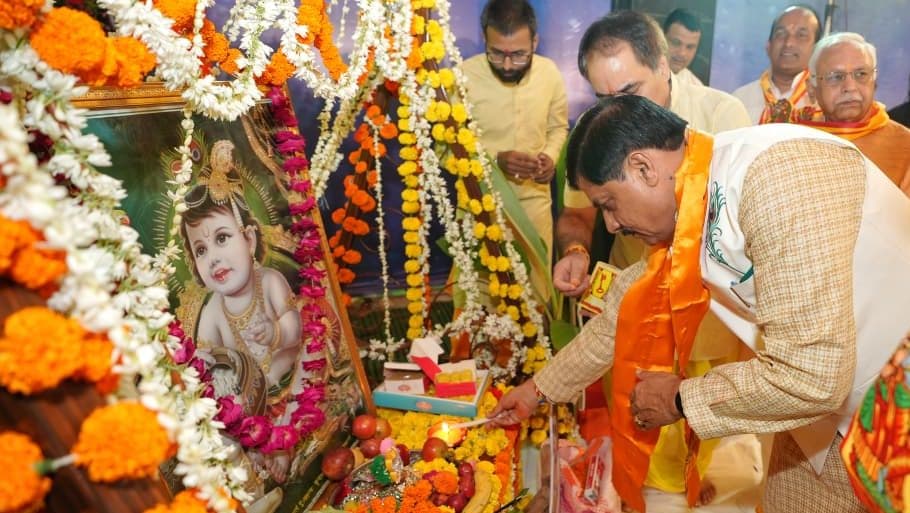A chubby, naughty child with an insatiable love for freshly churned butter, Lord Krishna, according to the legends, left his mother and neighbours exasperated with his ingenuity in stealing it.
This image of the deity as Natkhat Nandlal (mischievous Nandlal) or makhan chor (butter thief) is beloved of devotees. Its enduring appeal has seen it being portrayed in paintings over the centuries, especially by the Rajput and Pahari schools between the 16th and 18th Centuries; in modern-day calendars; and in literature, music, and dahi handi performances during Janmashtami. However, this image of Lord Krishna is set to undergo a transformation in Madhya Pradesh, where the culture department is preparing an exercise to reshape this portrayal.
According to Madhya Pradesh CM Mohan Yadav, Lord Krishna’s act of breaking pots filled with butter was an act of resistance against Kansa, the tyrant ruler of the Vrishni kingdom. But this story got distorted, according to him. “Krishna told his fellow cowherds: eat your butter, break the pot, but don’t let it reach our enemy. This was not theft but a message of resistance. Krishna’s story is about love and protest against injustice, not about stealing,” the CM explained at a Janmashtami celebration on August 16.
Taking the cue from the CM, his cultural advisor Ram Tiwari has begun chalking out plans to undertake a massive outreach campaign. In his office, Tiwari checks the time on his “Vedic clock” and asks his staff for the latest copies of the Bhagavad Gita. “We are not going to bring in a law, we will try to bring some changes to the school syllabus and give the right knowledge of Krishna to the children for sure,” he tells The Indian Express.
According to Tiwari, the Culture Department will also “inform religious leaders, scholars, preachers, and storytellers that Krishna’s act of butter stealing was actually symbolic of his revolt against Kansa’s policies, and there will be a check on the practice of popularising the butter-theft narrative”.
“In Ujjain, we are undertaking the rejuvenation of sites associated with Lord Krishna,” Tiwari says. “Krishna became Jagatguru there. We are creating ‘Sri Krishna Lok’, highlighting his vishwaroop shown to Arjun. In Raisen district, near Bareli, in the hills of Jamagad, the battle and marriage episodes related to Lord Krishna will be developed.”
The Mohan Yadav government has already surveyed 3,222 temples across the state, with plans to develop several prominent sites connected to the deity as part of its Krishna Patheya religious circuit. After killing Kansa, Lord Krishna is believed to have visited the ashram of Guru Sandipani in Ujjain, where he learned the 64 arts in 64 days, studied the Vedas and the Puranas, and befriended Sudama at the Narayana temple in Ujjain. His path next led him to the hill of Janapav Kuti, near modern-day Mhow in Indore district, where Lord Parashurama is believed to have bestowed him with spiritual knowledge and his divine weapon, the Sudarshan Chakra.
Then, responding to a request of Devi Rukmini, who was being forced into marriage with Shishupala, Lord Krishna arrived in what is now Amjhera in Dhar district to rescue her. Her brother Rukmi caught up with the couple in Bhopawar, now a village 15 km from Amjhera, and engaged in combat. After a fierce battle, Lord Krishna defeated Rukmi. Lord Krishna spared his life on Rukmini’s request and subsequently married her.
For the CM, whose turf is Ujjain, the political benefit arising out of the focus on Lord Krishna is two-fold. It burnishes his credentials in the Yadav community to which he belongs (the Yadavs, or Yaduvanshis, believe they descended from the deity), and the development of religious tourism centred around Ujjain serves his immediate political constituency.
However, it is not just Lord Krishna. The government, which heavily focused on the revival of local folk hero Vikramaditya in its first year by tying his legend to the construction of the Ram Mandir in Ayodhya, also plans to “clear misconceptions surrounding other Hindu deities such as Ram, Shiva, and Durga”.
“Our gods are often depicted with weapons, unlike deities in other cultures. But history shows that Hindus have never carried out destruction in the way we are accused of. Despite this, we are often portrayed as a violent society because of these depictions. These are some of the misconceptions we want to clear,” Tiwari says.

